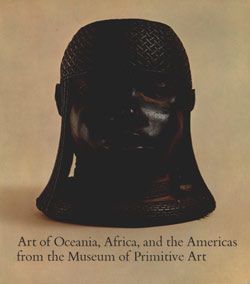Figure Pendant
Not on view
This small, globular pendant depicts a male figure wearing a folded paper headdress studded with three round jewels. On his face is an elaborate mask featuring a toothy grimace with exposed fangs and large, glaring eyes. His twisting, heliacal nose resembles a serpent’s body, with each end unraveling to form a pair of arched eyebrows. A similar motif decorates a ceramic vessel of Tlaloc, the rain god, interred long ago by the Aztecs in the Great Temple at Tenochtitlan (modern-day Mexico City). Whether in the form of nosepieces, crowns, or elaborate turquoise pectorals, two-headed serpents are abundant in Mesoamerican art and are commonly allied with concepts of water, fertility, and an aquatic afterlife.
Like the Mixtec serpent pendant [1978.412.117], this miniature figure is made of greenstone and perforated for suspension. Carved on a diminutive scale, the shape of the figure’s body is conveyed with only a few brief incisions, thereby reducing it to the fewest details needed in order to identify it as a water deity. Additionally, the green hue of the stone was itself symbolic of water, feathers, fecundity, and all things precious.
William T. Gassaway, 2014–15 Sylvan C. Coleman and Pamela Coleman Fellow
Due to rights restrictions, this image cannot be enlarged, viewed at full screen, or downloaded.
This artwork is meant to be viewed from right to left. Scroll left to view more.




